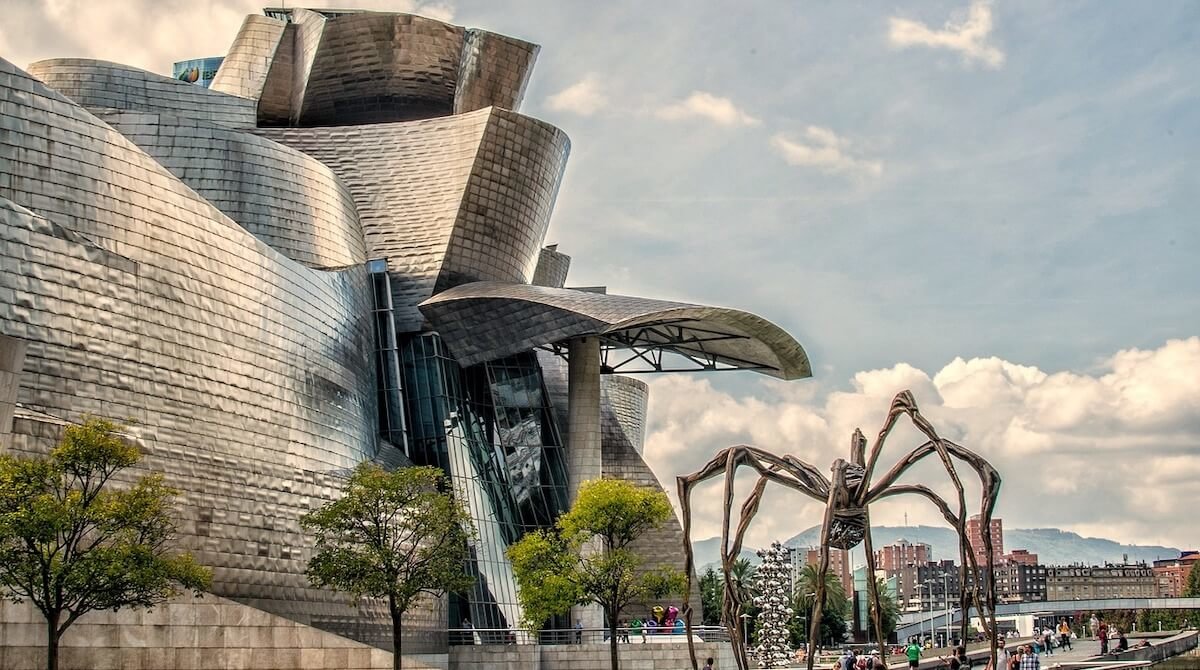Guggenheim Museum, the icon of Bilbao

The Guggenheim Museum Bilbao is the tourist engine of the Basque Country. Designed by the architect Frank Gerhy and inaugurated in 1997, it has become the icon of Bilbao
The Guggenheim Museum was a bet of the Basque Government that at first it was difficult to understand for many people from Bilbao who did not share that, in the midst of a crisis, it was decided to make an investment of this magnitude. The passage of time has shown that it was a great success, with which the investment made has been more than recovered and has placed Bilbao on the international tourist map, being visited by hundreds of thousands of people every year, including many renowned personalities. international.
It is a place that must be visited even if one is not an art fan, since there are only four museums like this in the whole world, a wonder that is worth enjoying if only for its beautiful building.
GUGGENHEIM BILBAO MUSEUM FILE
- How to get there: Bus, Tram, Metro and Renfe Cercanías
- Telephone: 94 435 90 80
- Address: Abandoibarra Avenue, 2
- Opened: 1997
- Design: Frank Gery
- Material: Limestone, titanium and crystal
HOW TO GET TO THE GUGGENHEIM BILBAO MUSEUM
The Guggenheim Museum is located in a central area of the city, on a plot of land that used to be an old factory and in a space that curves with respect to the river (Abandoibarra Etorbidea, 2). From Loiu Airport it can be accessed through the Bizkaibus service, which stops just 15 minutes from it.
In addition, once in Bilbao, Bilbobus lines 1, 10, 11, 13, 18, 27, 38, 48 and 71 have stops near the Museum, such as Henao, Alameda Rekalde, La Salve or Campo Volantín. It can also be reached by tram, getting off at the 'Parada Guggenheim' station and by Metro Bilbao (Moyua stop, Ercilla-Guggenheim exit).
WHO DESIGNED THE GUGGENHEIM BILBAO MUSEUM
The Guggenheim was designed by the architect Frank Gehry, a Canadian based in the United States, winner of the Pritzker Prize and recognized for the innovative and peculiar forms of the buildings he has designed, such as the Dancing House in Prague, the Walt Disney Concert Hall in Los Angeles, the Weisman Art Museum in Minneapolis or the Stata Center in Boston.
His architecture, belonging to the postmodern movement, is impressive, often made with unfinished materials. In the same building, he incorporates several simple geometric shapes, which create a visual current between them. His designs are not easy to assess for the inexperienced observer, since a good part of the design quality is found in the interplay of volumes and in the materials used in the facades, preferably metal, in all of which only the connoisseur recognizes. entirely harmony and structural design.
HISTORY OF THE GUGGENHEIM BILBAO MUSEUM
The history of the Guggenheim Museum cannot be understood without Solomon Robert Guggenheim, an American businessman and art enthusiast who in 1943 ordered Frank Lloyd Wright to build a museum in New York, which would be completed in 1959, arousing great admiration.
Later, the Guggenheim in Venice would arrive and in 1991, the Basque authorities signed an agreement with the Solomon Robert Guggenheim Foundation for the construction of a museum in Bilbao, at a cost of 20 million dollars, to which 50 million were added for the purchase of works of art and more than 10 million from the architect Frank Ghery, among other investments. In total, the cost of the work was 166 million euros, being inaugurated by King Juan Carlos I on October 18, 1997.
Soon the investment was more than justified, with the important impulse of tourism, the improvement of the image of Bilbao and the revitalization of the entire environment. This so-called 'Guggenheim effect' revealed the importance of cultural tourism.
THE GUGGENHEIM BILBAO MUSEUM BUILDING
The Museum has an area of 24,000 square meters, of which 9,000 are for exhibition space. Its design creates a structure perfectly integrated into the urban fabric of Bilbao and its surroundings. The highest part of the building is crowned by a large metal flower-shaped skylight that covers the Atrium, one of the most characteristic features of the building.
It is made up of 20 galleries, some classic and others with irregular shapes.
The construction, carried out in a curve of an old wharf for port and industrial use, began in 1993 and finished in 1997.
The Museum is surrounded by attractive promenades and squares in a recently urbanized area, its industrial past gone.
MATERIAL FROM THE GUGGENHEIM BILBAO MUSEUM
Each piece of the internal framework of the Museum is unique, cut to size and without symmetry with the rest. Limestone roofs, glass curtains, titanium plates, high-density polyethylene membranes, galvanized sheets, piles and laminated steel structures were used for this great work.
FACADE OF THE GUGGENHEIM BILBAO MUSEUM
For its outer 'skin', 33,000 very fine titanium plates were used, which achieve a rough and organic effect. This material was chosen for its physical and chemical resistance, as well as providing different shades depending on the impact of sunlight at all times.
Seen from the Ría, it resembles the shape of a boat, in homage to Bilbao, with the blades resembling the scales of a fish.
HOW TO GET TICKETS FOR THE GUGGENHEIM BILBAO MUSEUM
On Friday, admission to the Guggenheim Museum is free. For the rest of the days, the price is 12 euros for adults (10 euros online) and 6 euros for retirees over 65, pensioners, the disabled and students between 18 and 26 years (5 euros online ). In addition, admission for those under 18 years of age is always free, as is the case for members of Friends of the Museum.
Tickets can be obtained at the box office or through https://tickets.guggenheim-bilbao.eus/en
Group visits can also be made.
SCHEDULE OF THE GUGGENHEIM BILBAO MUSEUM
Opening hours are from 11:00 a.m. to 7:00 p.m. (from 10:00 a.m. on Easter, summer, All Saints Day, Constitution Day and Christmas), from Tuesday to Sunday. It also opens a few sporadic Mondays a year (check the calendar). The ticket offices close half an hour before the closing of the Museum and the eviction begins about 15 minutes before closing.
WHAT DAY IS THE GUGGENHEIM BILBAO MUSEUM FREE
The entrance to the Museum is free every Friday, Museum Day, as well as on May 18. In addition, it is always free for children under 12, as well as for those who have the ICOM card.
HOW LONG DOES IT TAKE TO SEE THE GUGGENHEIM BILBAO MUSEUM
The duration of the visit inside is approximately 2 hours, while contemplating the surroundings of the Museum can take an hour.
The ticket offices close half an hour before the closing of the Museum and the eviction begins about 15 minutes before closing.
PERMANENT EXHIBITION OF THE GUGGENHEIM BILBAO MUSEUM
The Museum has a large number of contemporary works, both local and international, acquired as property.
The Permanent Collection of the Guggenheim Museum is made up of works belonging to the Solomon R. Guggenheim Foundation, which includes the collections of the Solomon R. Guggenheim Museum in New York and the Peggy Guggenheim Collection in Venice, and the funds of the Guggenheim Museum Bilbao.
Taken together, these works offer a comprehensive perspective on the visual arts of the 20th and 21st centuries. The permanent installation 'La materia del tiempo (The Matter of Time, 1994–2005)', by Richard Serra, is one of the most emblematic works in the Guggenheim Bilbao Museum's Own Collection and unique in the world. In addition, you can enjoy the lobby, a room that, through visual language and impressive scenery, offers an immersive experience, and works such as 'The famous orders of the night (Die berühmten Orden der Nacht, 1997)', by Anselm Kiefer or the 'Metaphysical box by conjunction of two trihedrons. Homage to Leonardo (1958)', by Jorge Oteiza.
Look at the arrows on the ground, which will indicate the one-way route to follow.
TRAVELING EXHIBITIONS AT THE GUGGENHEIM BILBAO MUSEUM
Always at the forefront, the Guggenheim Museum has had dozens of traveling exhibitions of modern and contemporary art, as well as the fundamentals of current art, offering a broad vision of the international scene in the context of art history, many of them on loan by other renowned international museums
Currently you can see 'Sacred Room', by Monira Al Qadiri, which moves to the desert of Oman; the 'Fervent Celebration', by Jean Dubuffet; and 'From Fauvism to Surrealism: Masterpieces from the Musée d'Art Moderne de Paris'.
If you want to know the exhibition that is currently being programmed, you can consult the museum's website.
WHAT CELEBRITIES HAVE VISITED THE GUGGENHEIM BILBAO MUSEUM
It is almost easier to say which celebrities have not visited the Guggenheim Museum. And it is that numerous actors, film directors, musicians, politicians, cooks, architects or Nobel Prize winners have enjoyed the beauty that this icon of Bilbao hides.
In many cases they have discovered the Basque Country thanks to the Guggenheim and have fallen in love with the gastronomy, the landscapes and the charm of its people.
Both on a personal level and almost always incognito (or at least they have tried) and on a professional level, since the Guggenheim museum has appeared in many movies. Some of the well-known faces that have passed through the museum are the actors Samuel L. Jackson, William Dafoe, Brad Pitt, Jeff Bridges, Annette Bening, Michael Douglas or Salma Hayek, the musicians Charlie Watts, (Rolling Stones), Sting, Metallica or Mariah Carey, the writers Umberto Eco or Mario Vargas Llosa, the designers Carolina Herrera, Paco Rabanne or Giorgio Armani and personalities such as Prince Alberto of Monaco, Rigoberta Menchú, Jimmy Carter, etc.
In addition, renowned concerts have been held in its surroundings by groups such as Vetusta Morla, Arcade Fire or the most famous, that of Bob Dylan.
WHAT FILMS DOES THE GUGGENHEIM BILBAO MUSEUM COME ON
'The world is never enough', by Agent 007, played by Pierce Brosnan.
'Jupiter Ascending' (2015), directed by the Wachowski sisters
What is the name of the Guggenheim dog
Puppy, a name that in English refers to a dog puppy, is the iconic modern floral sculpture by the American artist Jeff Koons and located in front of the Guggenheim Museum. It represents a Scottish West Highland White Terrier puppy and is made up of a steel structure covered with approximately 38,000 natural plants, which are replaced twice a year.








